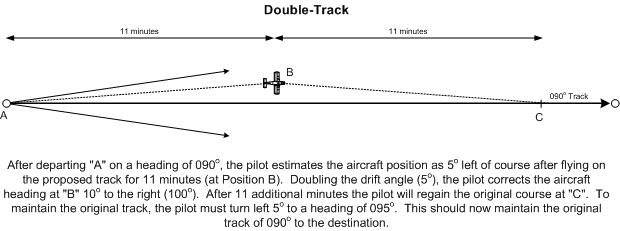
Methods of Course Correction
By definition, course correction is the process of correcting the compass heading in flight owing to drifting off the original planned course. Course correction therefore entails correcting the estimations that were previously made during the pre-flight planning. The drift is likely owing to incorrectly forecasted upper winds, but it could be the result of a calculation error. Since course corrections are done in the air, any aids—ruler, E6B, protractor, etc.—are not used.
Using the drift lines as aid to mental calculation, two methods of course correction methods can be easily used in the cockpit during flight. The first, referred to as the “double track” method, is used only during flight along first half of the course, while the second, referred to as the “opening/closing angle” method, is used most often during flight along the second half of the course.
Double-track Method
When drift error is recognized (usually at the first check point), a dot is placed on the map showing the erred position of the aircraft. Using the double-track method, the opening drift angle is estimated and noted (for example, 7°). To regain the correct track, this drift angle is doubled (14°), and then added or subtracted (depending on whether drift is to the right or left of the intended track) to/from the original heading that produced the drift error. If, for example, the original heading that produced the 7° drift were 090°, and if the drift were to the left of track, the new heading to fly would be 104°. When turning to this new intercept heading, the time is noted. The intercept heading is then flown for the same amount of time that the erred heading was flown (i.e., the time it took to fly from the set-heading point to the point at which error was detected). When the predetermined time expires, mathematics provides that the aircraft will arrive over the original track. When the original track is recovered, the correcting heading must be adjusted: take the heading that produced the drift error, plus or minus the original drift angle (for example 104° - 7° equals 090°). Another example appears below:

Opening-Closing Angle Method
Using the opening-closing angle method, the opening and closing angles are estimated and added together; this sum is then added to or subtracted from the heading which produced the drift error, depending on whether the drift was to the left or right of the intended track. The correcting heading using this method will take the aircraft directly to the destination. An example is presented below:

© 2007 David L. Parry
.jpg)

